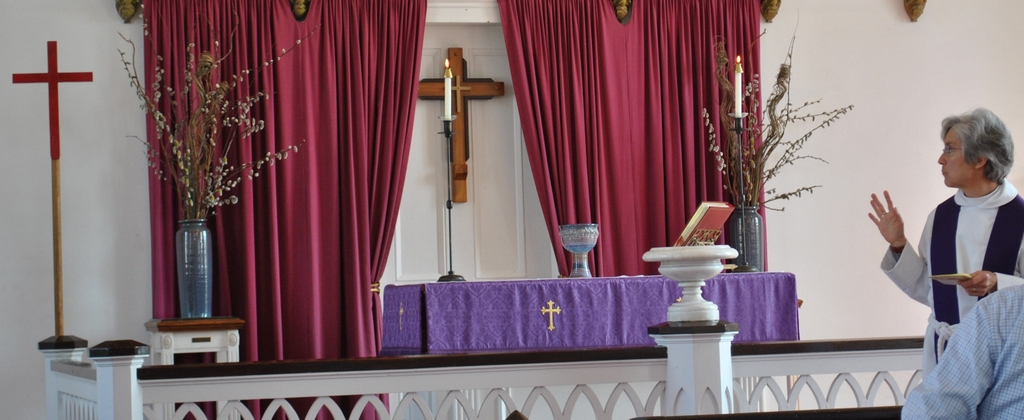
Lent brings not only a change in church seasons but visible changes to the service and content of the service. The most noticeable change is that of color. The use of purple symbolize both the pain and suffering leading up to the crucifixion of Jesus as well as being a color of Jesus’ royal kingship and of his royal priesthood. The altar, for instance, has hangings of purple.
We use different crosses in Lent. The “red” cross the Helmut made is a symbol of Jesus’ blood and suffering. A red cross is also called the St George’s Cross. He is the patron saint of England, and knights wore this distinctive emblem to display their allegiance.
There are no or minimal flowers on the altar during Lent, again reflecting the focus on repentance over celebration. Processional crosses and altar cross are often veiled in purple. Music tends to be more somber and used only as accompaniment and not as a solo instrument. Certainly objects are simpler. A pottery rather than a metal chalice is used for communion .
The service reflects a change of seasons. Rite 1 is used over Rite II which is more traditional and has features that are closely related to the themes of Lent, such as sin and confession. The Rite 1 Eucharist includes two biddings to confession, the first of which dates to 1548. This bidding begins, "Ye who do truly and earnestly repent you of your sins" (BCP, p. 330).The Rite 1 Eucharist allows one or more of four sentences of scripture to be said after the confession and absolution. These sentences, previously known as the "comfortable words," do not appear in the Rite 2 Eucharist.
The Agnus Dei and the prayer of humble access may be said after the breaking of the bread in the Rite 1 Eucharist (BCP, p. 337). These prayers are not presented as options in the Rite 2 Eucharist, although a suitable anthem may be used after the breaking of the bread. The Prayer of Humble Access emphasizes God’s mercy and Christ’s worthiness in the context of our unworthiness without him. At the end, the post-communion prayer is different, demanding our attention to the actual words of what we are praying
Optionally, the service starts with the Penitential Order, which focuses on confessing our sins and receiving forgiveness from the very beginning of our worship. On some weeks, we say The Decalogue (the Ten Commandments), to remind us that we worship a holy God and that being in relationship with him means we are called to be holy ourselves. Parts of the service are separated by silence.
We sing the Kyrie or Lord have mercy in place of the Gloria. Alleluias are dropped during Lent, reflecting that Lent is again about penitence over celebration.
